Most Latest Synchronous Motors MCQs ( Electrical Machines ) MCQs – Electrical Machines MCQs
Latest Electrical Machines MCQs
By practicing these MCQs of Synchronous Motors MCQs ( Electrical Machines ) MCQs – Latest Competitive MCQs , an individual for exams performs better than before. This post comprising of objective questions and answers related to “Synchronous Motors MCQs ( Electrical Machines ) Mcqs “. As wise people believe “Perfect Practice make a Man Perfect”. It is therefore practice these mcqs of Electrical Machines to approach the success. Tab this page to check “Synchronous Motors MCQs ( Electrical Machines )” for the preparation of competitive mcqs, FPSC mcqs, PPSC mcqs, SPSC mcqs, KPPSC mcqs, AJKPSC mcqs, BPSC mcqs, NTS mcqs, PTS mcqs, OTS mcqs, Atomic Energy mcqs, Pak Army mcqs, Pak Navy mcqs, CTS mcqs, ETEA mcqs and others.
Electrical Machines MCQs – Synchronous Motors MCQs ( Electrical Machines ) MCQs
The most occurred mcqs of Synchronous Motors MCQs ( Electrical Machines ) in past papers. Past papers of Synchronous Motors MCQs ( Electrical Machines ) Mcqs. Past papers of Synchronous Motors MCQs ( Electrical Machines ) Mcqs . Mcqs are the necessary part of any competitive / job related exams. The Mcqs having specific numbers in any written test. It is therefore everyone have to learn / remember the related Synchronous Motors MCQs ( Electrical Machines ) Mcqs. The Important series of Synchronous Motors MCQs ( Electrical Machines ) Mcqs are given below:
Synchronous Motor Phasor Diagram
1. Below is the phasor diagram of synchronous generator.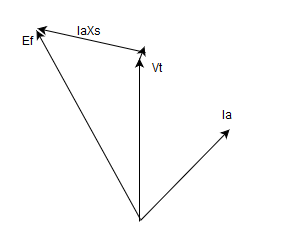
If the machine is made to run as synchronous motor, what will be the phasor diagram changes then?
a) Reverse Ia
b) Reverse Ef
c) Reverse Vt and Ia
d) Reverse Vt
Answer: a
Explanation: Only the direction of the armature current changes in the motor as it absorbs the electrical energy.
2. Below is the phasor diagram of synchronous generator.
If the machine is made to run as synchronous motor, what will be the new phasor diagram?
a)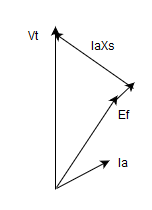
b)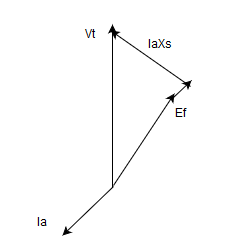
c)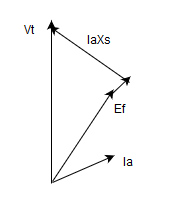
d)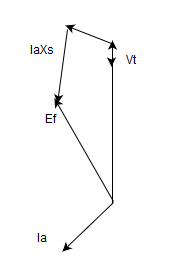
Answer: a
Explanation: Only the direction of the armature current changes in the motor as it absorbs the electrical energy. It has a component in phase opposite to Ef.
3. The voltage equation of synchronous motor is?
a) Ef = Vt + Ia*(ra+jXa)
b) Ef = Vt – Ia*(ra+jXa)
c) Ef = Vt + Ia*(ra-jXa)
d) Ef = Vt – Ia*(ra-jXa)
Answer: a
Explanation: The voltage equation of synchronous motor is Ef = Vt + Ia*(ra+jXa).
4. Synchronous motor delivers lagging power at __________
a) leading pf
b) lagging pf
c) zero pf
d) unity pf
Answer: a
Explanation: As Q < 0 for synchronous motor at leading pf.
5. A 420 V synchronous motor is working at 30° lagging load. What can be the expected phasor?
a)
b)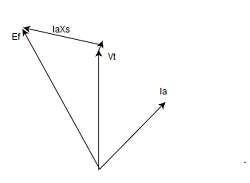
c)
d) None of the mentioned
Answer: a
Explanation: The Ia should lag Ef by 30°.
6. The synchronous motor is operating at upf load. The most suitable phasor will be?
a) 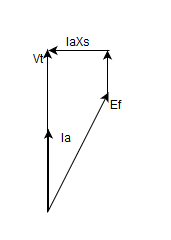
b) 
c) 
d) 
Answer: a
Explanation: Ia must be in phase with the Ef.
7. The zero power factor of an alternator can be obtained by _________ at rated Ia.
a) over exciting
b) conducting short circuit of secondary terminals
c) under excitation
d) running as reluctance motor
Answer: a
Explanation: By over exciting an alternator gives the additional flux required to make it operate at zero power factor.
8. From the figure shown below for the OCC and SCC of a three phase alternator, the point ‘L’ corresponds to _______ and the point ‘A’ can be obtained by _____ the alternator.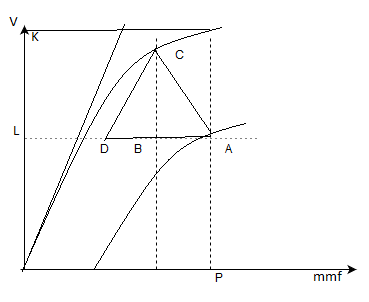
a) terminal voltage, over exciting
b) excitation voltage, over exciting
c) terminal voltage, under exciting
d) excitation voltage, under exciting
Answer: a
Explanation: The point ‘L’ corresponds to Vt and the point ‘A’ can be obtained by over exciting the alternator.
9. In the figure below, the point ‘F’ corresponds to _______ which can be obtained by ________
a) field current required to circulate short circuit current, SCC
b) field current required to circulate full load current, SCC
c) mmf required to cancel the hysteresis losses, SCC
d) mmf required to compensate the leakage reactances, SCC
Answer: a
Explanation: Point ‘F’ corresponds to the short circuit current and it is obtained by SCC plot.
10. The operating point for an over excited alternator working near zpf lagging power factor gives ‘A’ as the operating point. Then if the same machine is working as an over excited synchronous motor will give same operating point at __________
a) zpf leading
b) zpf lagging
c) upf
d) there will never be the same operating point for the machine as motor as well as generator
Answer: a
Explanation: Yes, by making it from lag to leading power factor, a synchronous machine can have same operating point for the alternator as well as synchronous motor.
11. Identify the over excited alternator operating at zpf.
a) 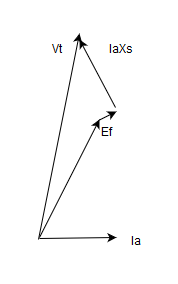
b) 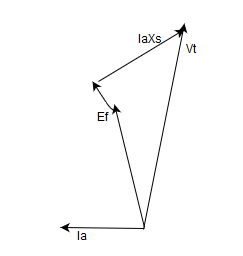
c) 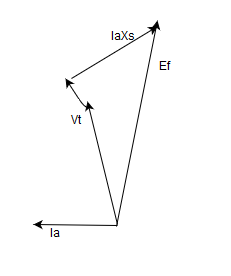
d) 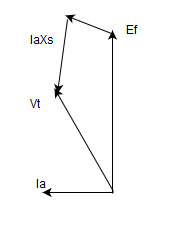
Answer: a
Explanation: Ef>Vt, makes it work as over excited.
12. Identify the over excited synchronous motor operating at zpf.
a) 
b) 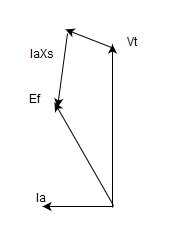
c) 
d)None of the mentioned
Answer: a
Explanation: Ef>Vt, and the Ia is in opposite to that of alternator.
13. For the below graph depicting the performance of a synchronous motor, coordinates ‘x’ and ‘y’ are respectively?
In the ‘V’ curve shown in the above figure for a synchronous motor, the parameter of x and y coordinates are, respectively.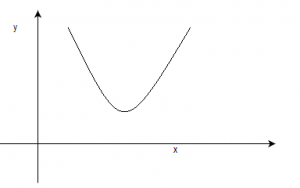
a) Armature current and field current
b) Power factor and field current
c) Armature current and torque
d) Torque and field current
Answer: a
Explanation: V curve is between the armature current and the field current.
14. We can increase the torque of a reluctance synchronous motor if we __________
a) Increase reluctance of the magnetic circuit along the direct axis
b) Decrease the reluctance of the magnetic circuit along the quadrature axis
c) Increase the ratio of the quadrature axis reluctance to direct axis reluctance
d) Decrease the ratio of quadrature axis reluctance to direct axis reluctance
Answer: c
Explanation: Te = -1/2(φ^2)(Rlq-Rld) sin2δ.
15. Switched reluctance motors are basically __________
a) salient pole synchronous motor but without excitation winding
b) stepper motor with salient poles
c) synchronous motor with salient poles on stator and rotor
d) stepper motor with closed loop control and with rotor position sensor
Answer: d
Explanation: A switched reluctance motor has stepper motor.
Power Factor Correction by Synchronous Motors
1. The magnetization current drawn from an AC supply a synchronous motor is used to _________
a) set up flux in magnetic circuit of device
b) compensate core losses
c) set up magnetizing armature reaction
d) all of the mentioned
Answer: a
Explanation: Magnetizing current sets up the flux needed in the machine.
2. A 3 phase synchronous motor is working at normal excitation, then the flux deficient in circuit is ________
a) given by armature winding mmf
b) given by field winding mmf
c) supplied to armature winding mmf
d) supplied to field winding mmf
Answer: a
Explanation: it is given by armature winding mmf.
3. The excess flux in synchronous motor is neutralized by ________
a) armature winding by drawing demagnetizing component of the current from ac supply
b) armature winding by drawing magnetizing component of the current from ac supply
c) field winding by drawing demagnetizing component of the current from dc supply
d) field winding by drawing magnetizing component of the current from dc supply
Answer: a
Explanation: Excess flux is neutralized y the demagnetizing component.
4. The V-curves of synchronous motor is plotted between ________
a) Ia Vs If with constant shaft load
b) If Vs Ia with constant shaft load
c) power factor vs If
d) power factor vs Ia
Answer: a
Explanation: The V-curves of synchronous motor is plotted between Ia Vs If with constant shaft load.
5. When a constant power output is desired to maintain ________
a) Ef*sinδ and Ia*cosθ are to be maintained constant
b) Ef*sinδ is be maintained constant
c) Ia*cosθ is to be maintained constant
d) Ef*sinδ and Ia*sinθ are to be maintained constant
Answer: a
Explanation: For constant real power output the component of the excitation voltage lagging to Vt should remain constant as per the phasor diagram.
6. When the excitation voltage is increased from 1 to 1.3 pu of a 3-phase synchronous motor. Then load angle for the constant power operation ________
a) must be decreased
b) can also be increased
c) increased
d) decreased
Answer: a
Explanation: ‘Ef*sinδ’ is to be maintained constant. so if excitation voltage increases then the load angle must decrease.
7. The armature current is ________ at UPF when compared to leading power factor.
a) minimum
b) maximum
c) equal
d) none of the mentioned
Answer: a
Explanation: 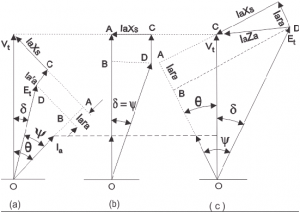
8. The armature current is _______ at UPF than motor at lagging power factor.
a) minimum
b) maximum
c) zero
d) none of the mentioned
Answer: a
Explanation: 
9. The inverted V plots is plotted between ________
a) power factor vs field current for constant shaft load
b) field current vs power factor for variable shaft load
c) armature current vs field current
d) terminal voltage vs power factor
Answer: a
Explanation: Inverted v-curves are plotted between power factor and field current for constant shaft load.
10. For a power system having induction motor loads, an overexcited synchronous motor is also attached. Then the over all power factor?
a) improves
b) degrades
c) becomes upf
d) remains same
Answer: a
Explanation: An over excited synchronous motor acts as a source of lagging reactive power and so the overall power factor improves.
11. For a power system having induction motor loads, an overexcited synchronous motor is also attached. The induction motor will now operate at ________
a) lagging
b) leading
c) reduced power factor
d) increased power factor
Answer: a
Explanation: Adding synchronous motor will improve the pf of the system but then the induction motor will still work at lagging pf only.
12. Synchronous compensators are ________
a) over excited synchronous motor with no mechanical load
b) over excited synchronous motor with mechanical load
c) under excited synchronous motor with no mechanical load
d) normally excited synchronous motor with no mechanical load
Answer: a
Explanation: Synchronous compensators are synchronous motor with no mechanical load which are overexcited.
13. For a synchronous motor, mark the appropriate.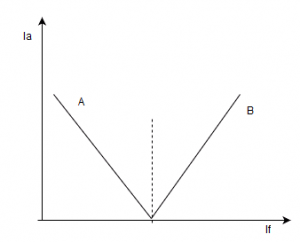
a) A-Inductor, B-Capacitor
b) A-Capacitor, B-Resistor
c) A-Inductor, B-Inductor
d) A-Capacitor, b-Inductor
Answer: a
Explanation: A will act as the inductor curve consuming the reactive power while the B curve is like capacitor.
14. (I) Speed of an isolated alternator can be altered.
(II) Speed of an alternator connected to IBB can be also altered.
a) I is true, II is false
b) Both the statements are true
c) I is false while II is true
d) Both are false
Answer: a
Explanation: Speed of the alternator connected to the infinite bus bas can not be changes as it has to be of fixed frequency.
15. (I)For constant power of an isolated alternator, V-curves can be obtained.
(II)For constant power of an alternator connected to IBB, V-curves can be obtained.
a) I is true, II is false
b) Both the statements are true
c) I is false while II is true
d) Both are false
Answer: c
Explanation: For an isolated alternator working at constant power, we can not alter the armature current to have a v-curve while the is possible for the machine connected to infinite bus bar.
16. The operating frequency and voltage of an isolated alternator ________ if the prime mover input to motor is increased.
a) increases
b) decreases
c) remains constant
d) no relation exists between the power and frequency
Answer: a
Explanation: By varying the prime mover torque, the load angle as well as the operating frequency also get affected.
17. The active power delivered by an alternator will _______ when the prime mover input is increased for the alternator connected to infinite bus bar.
a) increases
b) decreases
c) remains constant
d) no relation exists between the power and prime mover droop characteristic
Answer: a
Explanation: The load angle will increase and so the real power will increase in case the prime mover input is increased.
Starting of Synchronous Motors
1. Synchronous motors are ___________
a) not self starting
b) self starting
c) single excited
d) none of the mentioned
Answer: a
Explanation: The average torque developed in the synchronous motor is zero.
2. Which method is/are used to perform magnetic locking?
I. Auxiliary motor
II. Dc motor
III. induction motor
a) I, II, III
b) II, III
c) II, I
d) II
Answer: a
Explanation: A sub motor is needed to make the synchronous machine run till the speed of synchronous speed and to achieve that we need additional motor.
3. Auxiliary method of starting is not possib1e due to the fact that ____________
a) it can not be started under load
b) it can be only started under load
c) it is less efficient
d) all of the mentioned
Answer: a
Explanation: Auxiliary motors usually reduces the performance indices of the synchronous machine when started under load.
4. Rating of the dc motor to be used in the starting of SM, should be higher than the synchronous motor.
a) True
b) False
Answer: b
Explanation: No, the dc motor used as pony motor is of lower rating than the synchronous motor it starts.
5. A synchronous machine with its field winding on stator and polyphase armature winding on rotor. At steady state, which of the following is not true for its air gap field?
a) stationary w.r.t. stator
b) rotating at double the speed Ns w.r.t. rotor
c) rotating in direction opposite to rotor
d) rotating at Ns w.r.t. rotor
Answer: d
Explanation: The air gap will not be at synchronous speed w.r.t. rotor.
6. A synchronous machine with its field winding on rotor and polyphase armature winding on stator. At steady state running condition, its air gap field is?
I. stationary w.r.t. stator
II. rotating at double the Ns w.r.t. rotor
III. rotating at -Ns w.r.t. rotor
IV. stationary w.r.t. rotor.
a) IV
b) I, II, IV
c) II, IV
d) I
Answer: a
Explanation: The excitation is given on rotor so the air gap field will be stationary w.r.t. rotor.
7. Consider a 3-phase cylindrical-rotor alternator.
A. E.m.f. generated by armature reaction lags armature current by 90°.
B. Air gap voltage leads the field flux by 90°
C. Air gap voltage lags the field flux by 90°
D. Armature reaction due to intermediate lagging p.f is partly cross
magnetizing & partly magnetizing
a) A, B
b) A, C, D
c) B, D
d) A, B, D
Answer: a
Explanation: Having cross magnetizing armature reaction in the machine means partial magnetization and demagnetization, adding another clause is useless.
8. These days alternators are designed to have larger air gaps for __________
a) stable parallel operation
b) higher stability limit
c) sinusoidal mmf distribution
d) all of the mentioned
Answer: a
Explanation: Large air gap ensures more SCR value and better performances.
9. Consider the following statements and mark appropriately.
I. In a cylindrical-rotor synchronous machine, armature flux is in
phase with armature current.
II. In salient pole machine, armature flux lags the armature current.
a) I is true
b) II is true
c) I and II are true
d) None of them are true
Answer: c
Explanation: In CRSM, there is no saliency and the armature flux follows armature current in phase.
10. In a 3-phase cylindrical-rotor alternator, synchronous reactance is sum of mutual and leakage reactance.
a) True
b) False
Answer: b
Explanation: Xs = magnetizing reactance + leakage reactance.
11. A 3-phase, 400V, synchronous motor is providing load at 0.8 p.f. lagging. If the field current of the motor is continuously increased, then the _____________
a) power factor increases and then decreases
b) power factor is not affected
c) power factor decreases upto a certain value of field current and then increases
d) power facor increases simply
Answer: a
Explanation: The magnetization current is increased as we increase the excitation, so the power factor will increase upto the saturation and then again it will decrease.
12. A synchronous machine is operating at constant load and at unity power factor. If its excitation is increased and then it operates as ___________
a) motor at leading p.f
b) motor at lagging p.f
c) absorber of reactive power
d) generator at leading p.f
Answer: a
Explanation: It will operate at leading p.f. if it was in motoring mode.
13. A synchronous machine is operating at constant load and at unity power factor. If its excitation is increased, then it operates as ___________
a) generator at lagging p.f
b) motor at lagging p.f
c) absorber of reactive power
d) generator at leading p.f
Answer: a
Explanation: It will operate at lagging p.f. if it was working as generator.
14. The reactive power output of a synchronous generator is limited by ___________
a) armature current and field current
b) field current and load angle
c) load angle and prime mover input
d) armature current and prime mover input
Answer: a
Explanation: Q=f(Ia,If).
15. Power factor of a synchronous motor varies when the ___________
a) applied voltage is varied
b) load is changed
c) supply frequency and field excitation is changed
d) all of the mentioned
Answer: a
Explanation: p.f. = f(V,E,f,Field current).
Most Latest Synchronous Motors MCQs ( Electrical Machines ) MCQs – Electrical Machines MCQs
